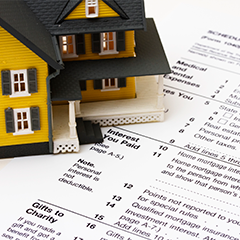Section 179 Deductions for Real Estate Expenses – the Options
 The Bottom line: The Section 179 Tax Deduction is meant to encourage businesses to stay competitive by purchasing needed real estate & equipment, and writing off a portion of it on their taxes for the current year.
The Bottom line: The Section 179 Tax Deduction is meant to encourage businesses to stay competitive by purchasing needed real estate & equipment, and writing off a portion of it on their taxes for the current year.The Protecting Americans from Tax Hikes (PATH) Act of 2015 made the section 179 deduction for qualified real estate permanent. If you are a taxpayer, section 179 permits you to, on your tax returns, deduct the actual cost of the respective property designated to be capitalized and/or depreciated. This is in lieu of requiring the property to be capitalized and/or depreciated over time on the books. Until the Small Business Jobs Act of 2010 was implemented, physical buildings were not eligible for classification as qualified real estate; buildings and real property are now eligible.
As a rule of thumb, qualified real estate only includes tangible personal property which can be depreciated according to section 179. This real estate must have also been acquired for utilization in active business or trade during the tax year in question. The property which is depreciable, but does not meet section 179 criteria, is still eligible for depreciation according to sections 167 and 168 if the modified accelerated cost recovery system (MACRS) depreciation is used. Some businesses or individuals may choose sections 167 or 168 despite being eligible for a section 179 deduction; this would most likely be done if a tax benefit was on the horizon.
Keep in mind that a section 179 election is irreversible and can only be taken in the year that your construction or equipment was put into service. Three criteria must be met in order for your business to qualify for section 179:
- The Dollar Limitation on Deductions– for tax years 2010 – 2016, the maximum deduction allowed is $500,000. Due to inflation, tax year 2017 will increase this allowable deduction up to $510,000. Large businesses will not benefit greatly from this deduction simply because of their size and revenue; midsize and smaller businesses will reap more savings considering the low thresholds just mentioned.
- The Dollar Thresholds– for tax years before 2015, any taxpayer who classifies more than $2,000,000 privy to section 179, a dollar limitation on the deduction is lowered, dollar for dollar, by the amount over $2,000,000. Inflation will come into play here for every tax year; for 2016, the threshold is raised to $2,010,000 and for 2017 this figure is increased to $2,030,000
- The Income Thresholds– section 179 explicitly states that a taxpayer’s taxable year deduction cannot exceed that respective tax holders aggregate income. This aggregate income is based on a calculation from active business or conduct of trade during the tax year in question.
 Please note that section 179 deductions cannot be claimed if these deductions will result in an overall tax loss for the tax year in question. Additionally, If you operate an entity as an S corporation, limited liability company (LLC) or partnership, calculations pertaining to any section 179 deductions is very intricate- this is because both the entity-level and individual-level are taxed under IRS regulations.
Please note that section 179 deductions cannot be claimed if these deductions will result in an overall tax loss for the tax year in question. Additionally, If you operate an entity as an S corporation, limited liability company (LLC) or partnership, calculations pertaining to any section 179 deductions is very intricate- this is because both the entity-level and individual-level are taxed under IRS regulations.
There are pros, cons, and areas of neutrality when it comes down to opting for a section 179 deduction. Section 179 is already a very complicated regulation but now that real property is eligible for the deduction, it is quite necessary to determine what exactly can be categorized as one of these qualified real property costs. We have outlined the most important real estate accounting scenarios you might encounter when determining section 179 eligibility.
Qualified Restaurant Property Expenses
Renovation, improvement and building costs will allow you to qualify. An important stipulation, however, is that your business needs to be qualified as an actual restaurant; this translates into over 50% of your structure’s square footage be exclusively used for meal consumption, seating, kitchens, and food preparation areas.
Qualified Improvement Property Expenses
If you have nonresidential interior building expenditures, these will qualify…with the exception of certain improvements such as those which are structural or your elevator system. In order to qualify for a deduction for the tax year 2016, property improvements must be made on a leased property. Also, any improvements must have been made more than three years after the property was put into full use.
Qualified Retail Property Expenses
Stipulations for qualifying in the retail property area include having a nonresidential property where improvements have been made on the interior, having a nonresidential property which is used to sell tangible personal items and having a nonresidential property which is open to the public. As with improvement property expenses, elevators and structural changes are not eligible and improvements must have been made more than three years after the property was put into full use.
Pros & Cons – Write-Offs vs. Regular Depreciation
Qualified real property costs eligible for the section 179 deduction allow those costs to be entirely written off in year one. This is in stark contrast to depreciation laws set forth by the IRS whereby you would write-off your expenses over a period of 39 years using straight line depreciation. A clear advantage when it comes to timing is present in the case you use the clauses of section 179.
Conversely, a negative effect on individual taxpayers is realized with a section 179 deduction because those deductions would be classified as normal income should the property be sold. Long-term capital gains are taxed at a significantly lower rate than ordinary gains for a taxpayer.
Regular income to a taxpayer can be taxed at 39.6% in the current economic environment; the highest tax that can be levied on capital gains is 25%. This is not even taking into account the net investment income tax (NIIT) of 3.8% which was introduced as part of the Affordable Care Act.
Conclusion
We have provided you with the basics on section 179 for qualified real estate costs. We have reviewed potential limitations as well as which expenses can qualify for section 179 deductions. We also took a deep dive into the workings of depreciation under IRS regulations. Working with a qualified CPA and advisor is the best way for you to guarantee that your business is making the most of section 179 and what it can offer. ![]()










